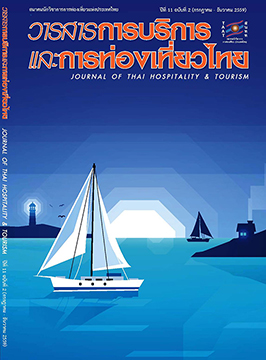การท่องเที่ยวที่ไร้ความเร่งรีบ
Main Article Content
บทคัดย่อ
แนวคิดและหลักการการท่องเที่ยวที่ไร้ความเร่งรีบสามารถนำมาประยุกต์ใช้ในการพัฒนาการท่องเที่ยวที่ตรงกับความต้องการของนักท่องเที่ยวในปัจจุบันได้ รวมทั้งเพื่อพัฒนาการท่องเที่ยวเพื่อไปสู่ความยั่งยืนอันจะก่อให้เกิดประโยชน์ต่อของผู้มีส่วนได้ส่วนเสียในการท่องเที่ยว ทั้งนี้ต้องเป็นการเดินทางท่องเที่ยวที่ใช้ระยะเวลาที่นานเพียงพอในแหล่งท่องเที่ยวเพื่อผ่อนคลายความตึงเครียดและเสริมสร้างพลังงานโดยให้เวลาและโอกาสในการซึมซับประสบการณ์ ในขณะท่องเที่ยวเพื่อที่จะได้เกิดการเรียนรู้และเกิดความเข้าใจในธรรมชาติ ประวัติศาสตร์ และวิถีชีวิตความเป็นอยู่ของคนในท้องถิ่นโดยเน้นคุณภาพของประสบการณ์ที่ได้รับจากการท่องเที่ยวและพบปะผู้คนในท้องถิ่นและสถานที่ใหม่ด้วยการสัมผัสโดยประสาททั้งห้า มิใช่แค่สิ่งที่มองเห็นโดยสายตาเพียงอย่างเดียว จากการวิเคราะห์เอกสารในประเด็นของหลักการการท่องเที่ยวที่ไร้ความเร่งรีบ สามารถสรุปหลักการที่สามารถจะทำให้เกิดการท่องเที่ยวที่ไร้ความเร่งรีบที่ประสบความสำเร็จได้ดังนี้ 1) ความยั่งยืน 2) เรียนรู้กับท้องถิ่น 3) อาหารปลอดสารพิษ 4) ส่งเสริมการมีสุขภาพดี 5) เวลา 6) โอกาส 7) ความเข้าใจ 8) ความรับผิดชอบ 9) ความประทับใจ 10) ความพึงพอใจ 11) การเคลื่อนไหว
Article Details
เอกสารอ้างอิง
[2] Caffyn, A. (2009). The Slow Route to New Market. Retrieved 26 February 2014 from https://www.alisoncaffyn.co.uk/index.php?option=com_content&task=view&id=14&Itemid=32
[3] Cook, R. A., Yale, L. J., & Marqua, J. J. (2010). Tourism: the Business of Travel, 4th edition, New Jersey: Pearson Prentice Hall.
[4] Conway, D., & Timms, B. F. (2010). Re-Branding Alternative Tourism in the Caribbean: The Case for ‘Slow Tourism’. Tourism & Hospitality Research, 18(4), 329-344.
[5] Dickinson, J. E., Robbins, D., & Lumsdon, L. (2010). Holiday Travel Discourses & Climate Change. Journal of Transport Geography, 18(3), 482-489.
[6] Dickinson, J., & Robbins, E. (2008). Representations of Tourism Transport Problem in a Rural Destination. Tourism Management, 29, 1110-1121.
[7] Dickinson, J., & Lumsdon, L. (2010). Slow Travel and Tourism. Earthscan, London, Washington, DC.
[8] Eisichaikul, Ranee. (2013). Learning through Interpretation for European Senior Tourists in Thailand: Slow Tourism Domain. International Journal of Business and Management Studies, 2(2):197–212.
[9] Esichaikul, Ranee., & Songsonthonwong, Chatchapol. (2012). Slow Tourism: Learning Through Interpretation for European Senior Tourists. Journal of Thai Hospitality & Tourism, 7(1), 41-57.
[10] Lea, J. (1988). Tourism and Development in the Third World. London: Routledge
[11] Slow Food Association. (2014). About us. Retrieved 27 March 2014 from Slow Food Association website: http//www.slowfood.com/international/1/about-us.
[12] Lee, K-H., Packer, J., & Scott, N. (2015). Travel Lifestyle Preferences and Destination Activity Choices of Slow Food Members and Non-members. Tourism Management. 1-10.
[13] Lumsdon, L. M., & McGrath, P. (2011). Developing a Conceptual Framework for Slow Travel: A Grounded Theory Approach. Journal of Sustainable Tourism, 19(3), 265-279.
[14] Matos, R. (2004). Can Slow Tourism Bring New Life to Alpine Regions? In Klaus Welermair & Christine Mathies (ed), The Tourism & Leisure Industry: Shaping the Future, New York: Hospitality Press.
[15] Peeters, P. (2007). Mitigating Tourism’s Contribution to Climate Change – an Introduction. In P. Peeter (ed) Tourism and Climate Change Mitigation: Methods, Greenhouse Gas Reductions and Policies and Policies. Breda: Stitching NHTV Breda, 11-16.
[16] Petrini, C. (2003). Slow Food: The Case for Taste. New York: Columbia University Press.
[17] Robinson, P., Heitman, S., & Dieke, P. (2011). Slow Food, Slow Cities & Slow Tourism, Research Themes for Tourism. 114-127.
[18] Slow Food Association. (2014). About us. Retrieved 27 March 2014 from Slow Food Association website: http//www.slowfood.com/international/1/about-us.
[19] Slow Tourism Network. (2013). Slow Philosophy. Retrieved 20 May 2013 from https://www.slowtourism.net/contentsite/index.php?option=com_content&view=article&id=61&Itemid=0&lang=en
[20] Salvo, P. D. (2013). “Repellent” Tourist versus “Slow” Tourist. European Journal of Tourism, Hospitality & Recreation, 4(2), 131-148.
[21] Tongsong, Chondarong. (2015). A Concept for Developing Slow Tourism in Thailand. Research Methodology & Cognitive Science, 12(2), October 2014 – March 2015.
[22] Yoopetch, Chanin. (2012). The Rapidly of Slow Tourism. Journal THM Quarterly Review 2012 (5), 5-6.
[23] Yurtseven, H., & Kaya, O. (2011). Slow Tourist: A Comparative Research Based on Cittaslow Principle. American International Journal of Contemporary Research, 1(2), 91-98.


